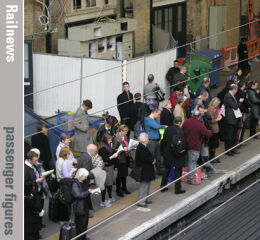Posted 14th June 2024 | 2 Comments
Passenger figures continue recovery, but commuter totals fall again

The recovery of the passenger rail business is continuing in the wake of the Covid pandemic, according to new figures released by the Office of Rail and Road. But the proportion of journeys made by commuters is still declining.
Annual revenue has topped £10 billion for the first time since 2019, and totalled £10.3 billion in the year to 31 March 2024. This was a 13 per cent increase if compared with the £9.1 billion in the previous year, when adjusted for inflation. In the last year before Covid, 2019-2020, revenue from passenger services was £10.4 billion.
The number of people travelling by train and the distances they covered have also continued to rise.
A total of 1.61 billion journeys were made between1 April 2023 and 31 March this year, which was an increase of 16 per cent compared with the previous year, although the total in 2019-20 was 1.74 billion. This was the highest figure recorded since the 1920s, although there is an element of statistical inflation because modern journey totals count each train used during a trip, and cannot take account of split ticketing.
Passenger kilometres were also up, at 60.1 billion. This was a 13 per cent increase on the 53.0 billion in 2022-23, but still below the 66.7 billion kilometres travelled in 2019-2020.
The earliest equivalent figure available in historical records is for 1934, when it was approximately 34 billion kilometres. Until modern times the highest totals were recorded during the Second World War. The peak of 56.7 billion kilometres was recorded in 1945, when many thousands of demobbed troops were travelling home.
Meanwhile, the number of commuters is still falling. The proportion of journeys made using season tickets is down from 34 per cent in 2019-20 to 13 per cent in 2023-24, and this was two percentage points lower than in 2022-23. Commuters now account for fewer than one in eight passengers, compared with one in three before the pandemic.
Reader Comments:
Views expressed in submitted comments are that of the author, and not necessarily shared by Railnews.

Martin marrison, HAYWARDS HEATH
I think with commuter traffic if someone is going into the office one or two days of the week I believe that they are more likely to drive to the office as the normal peak return works out so expensive.
Perhaps we will see Scotrails withdrawal of peak teaks spread to other TOCs to entice commuters back?
Many office jobs now advertise hybrid working so the annual season tickets will only reduce in my opion....
Chris Jones-Bridger, Buckley Flintshire
Yes again positive signs that the rail industry is recovering from the enforced restrictions imposed by the covid pandemic. However to be pedantic does the decline of season ticket sales provide an accurate assessment of commuter volume? With flexible working more use is now being made of other ticket products. Also the Elizabeth line has absorbed existing high volume commuter routes offering ticketing options other than traditional season tickets.
[Not sure the EL is mopping up all the commuters from outer stations to the east and west of London, considering that faster trains from places like Reading also exist. As far as flexible working goes, anyone only popping into the office now and then is not travelling 'regularly', which is part of the definition of 'commuter' (OED). Season tickets do appear to be a reasonable measure of core commuter demand.--Ed.]